|
Colors
on the Moon II
Tri-Color
CCD results
Uploaded 2/23/03

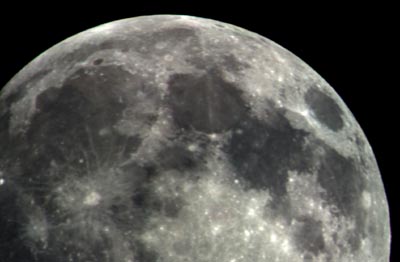 |
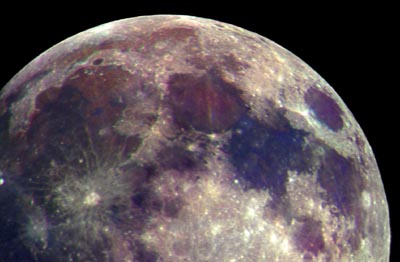 |
|
Click on
the above image for a 2x size |
Click on
the above image for a 2x size |
The Moon is usually represented
by images in shades of grays and pure black. We now know however
that the moon is geologically differentiated, and the various
rock types have certain pale hues which can be easily recorded
by film and CCD. What prompted me to do this project was the
article in the March 1996 issue of Sky and Telescope on Lunar
coloration. You can see a scan of the single page article HERE. The image on the left is a standard
three color RGB image of the moon taken with my ST8i CCD, properly
darkframe subtracted and flat fielded. The eye will see a view
similar to this. On the right, the color saturation has been
increased about 75 %, revealing the blues, yellows, and ruddy
coloration of the various geologic rock types. For example, the
Sea of Tranquility is quite bluish, due to basalt with high levels
of titanium. Mare Serenitatis is brownish red showing a later
lava flow over the blue, and Mare Imbrium is quite a mix of blue
and reddish lavas. Some of the colored regions on the moon have
earned names as well, as listed below.
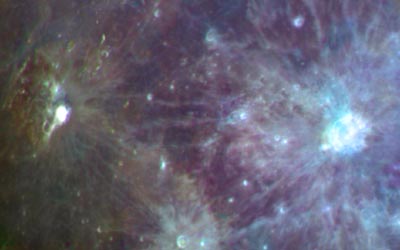 |
Click on
the image for a 2x size
Woods Spot, Aristarchus,
and Copernicus.
The very bright crater
to the left is Aristarchus, and just to its left is one of the
most intensely colored areas on the moon, known as "Woods
Spot". This contains the famous Schroters Valley and is
an extended lava flow. Copernicus is bluish, and represents much
younger material excavated from the depths.
|
 |
Click on
the image for a 2x size
Mare Imbrium, Sinus
Iridium Region
One of the best known areas
on the Moon for color contrasts in lava flows. The bluish gray
floor of Imbrium has been overlain by a billion year old reddish
flow that took place later in time. Sinus Iridium is fully filled
in with the reddish material, and part of Plato is as well.
|
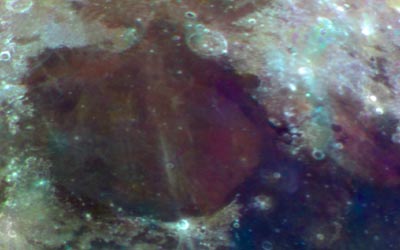 |
Click on
the image for a 2x size
Mare Serenitatis
and Tranquillitatis
Another superb area for
comparative coloration. The steely blue of Tranquility is quite
a contrast against the ruddy lava flows in Serenity.
|
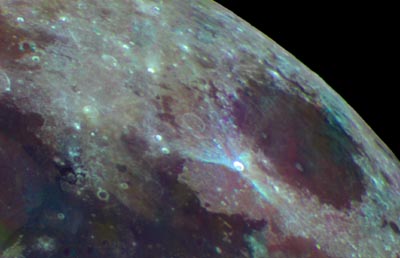 |
Click on
the image for a 2x size
Proclus and Mare
Crisium Area
Note the blue rays extending
from the brilliant fresh crater Proclus in the lower center of
the frame. Just below it, Palus Somni is a bit reddish, as is
a strip of lava to Proclus's upper right in Crisium.
|
Instrument: 12.5" f/5 Newtonian
Date: 2/15/03
Platform: Astrophysics 1200
Exposure: .1
Filters: RGB
Location: Payson, Arizona
Elevation: 5150 ft.
Sky: Seeing 5/10, Transparency 8/10
Outside Temperature: 0 C
Processing Tools: Photoshop, Maxim
Previous Uploads:
Comet Neat V1
Comet Linear RX14
More Aurora From Payson
Leonid Meteors
LMC-2 From the Outback
LMC -1 from the Outback of Australia
The SMC from Queensland
Atmospheric Phenomenon During Sunset at Karumba
Photographing Payson Aurora with new All Sky Camera
First Nighttime Tests of New All sky Camera
A New All Sky Camera for 35mm and Digital Photography
New images of Comet Linear WM1In Cetus on 12/06/01
New images of Linear WM1 11/09/01
Another Major Northern Lights Display from Payson, Arizona
The fading comet linear A2
More lunar Closeups - 3
The art of Deconvolving Lunar Images
Comet Linear A2 with Jet Sprays
Three faces of Comet Linear
Comet Linear A2 6-27-01
Van Cittert Deconvolution of the Lunar Highlands
More Northern Lights and the ISS over Payson
The NGC891 Galaxy Group Notes
CCD Shots during Full Moon
Comet Linear July 19 & 25th, 2000
Latest image of Comet Linear S4
Spectacular Red Aurora over Payson Arizona
Fuji's New Formulation of it new Super HQ100
FIRST TESTS OF HYPERED FUJI HQ100
First Schmidt shots with PJ400
First Tricolor shots with 2415
Test Images with Fuji NPH400First Two Comets with the new CCD Camera
HOME GALAXIES EMISSION NEBS REFLECTION NEBS COMETS GLOBULARS OPEN CLUST PLANETARIES LINKS
|
|





